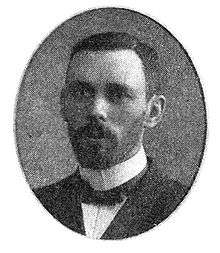Carl Wilhelm Oseen
Carl Wilhelm Oseen (17 April 1879 in Lund – 7 November 1944 in Uppsala) was a theoretical physicist in Uppsala and Director of the Nobel Institute for Theoretical Physics in Stockholm.

Life
Oseen was born in Lund, and took a Fil. Kund. degree at Lund University in 1897.[1]
Work
Oseen formulated the fundamentals of the elasticity theory of liquid crystals (Oseen elasticity theory), as well as the Oseen equations for viscous fluid flow at small Reynolds numbers. He gave his name to the Oseen tensor and, with Horace Lamb, to the Lamb–Oseen vortex. The Basset–Boussinesq–Oseen (BBO) equation describes the motion of – and forces on – a particle moving in an unsteady flow at low Reynolds numbers.
Nobel committee
Oseen was a member of the Royal Swedish Academy of Sciences from 1921, and a member of the Academy's Nobel Prize committee for physics from 1922. As a full professor of a Swedish university, Oseen also had the right to nominate Nobel Prize winners.
Oseen nominated Albert Einstein for the Nobel Prize in 1921, for Einstein's work on the photoelectric effect (rather than the more controversial theory of general relativity). Einstein was finally awarded the prize for 1921 when Oseen repeated the nomination in 1922.[3]
Selected bibliography
- Oseen, C. W. (1927). Neuere Methoden und Ergebnisse in der Hydrodynamik [Newer Methods and Results in Hydrodynamics] (in German). Berlin: Akademie Verlag.
- Oseen, C. W. (1933). "The theory of liquid crystals". Transactions of the Faraday Society. 29 (140): 883–885. doi:10.1039/tf9332900883.
See also
- Oseen equations
- Oseen's approximation
- Lamb–Oseen vortex
- Basset–Boussinesq–Oseen equation
- Ewald–Oseen extinction theorem
References
- Gieser, Suzanne (1993). "Philosophy and modern physics in Sweden: C.W. Oseen, Oskar Klein, and the intellectual traditions of Uppsala and Lund, 1920-1940". In Svante Lindquist (ed.). Center on the Periphery: Historical Aspects of 20th-century Swedish Physics. Science History Publications. pp. 24–41.
- Oseen, C. W. (1937). "Probleme der geometrischen Optik". In: Comptes rendus du Congrès international des mathématiciens: Oslo, 1936. vol. 1. pp. 171–185.
- Pais, Abraham (1982). Subtle is the Lord: The science and the life of Albert Einstein. Oxford. pp. 509–510.
Further reading
- Broberg, Gunnar. (1984) "Before 1932: Scientists writing their own history". History of Science in Sweden: the Growth of a Discipline, 1932-1982. Uppsala: Uppsala Studies in the History of Science. pp 9–24.